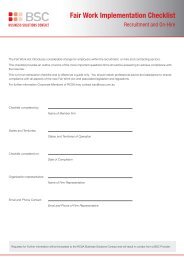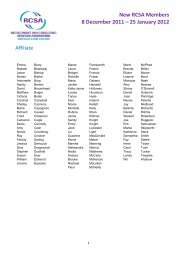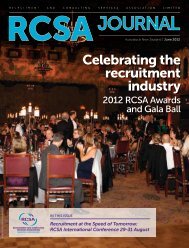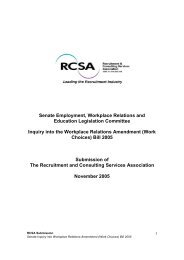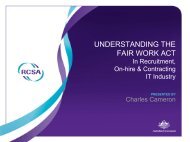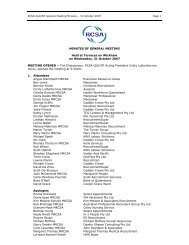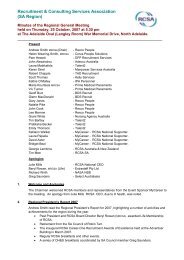Unfair Dismissal - RCSA
Unfair Dismissal - RCSA
Unfair Dismissal - RCSA
You also want an ePaper? Increase the reach of your titles
YUMPU automatically turns print PDFs into web optimized ePapers that Google loves.
General Protections<br />
The provisions concerning genuine redundancy do not cover the process for selecting<br />
individual employees for redundancy. If the reason a person is selected for redundancy is<br />
unlawful under the General Protections provisions (for example, on the basis of race, sex or<br />
religion amongst others) then the person will be able to bring an action for an alleged<br />
contravention of the General Protections in Part 3‐1 of the Fair Work Act 2009.<br />
Who can make an unfair dismissal claim?<br />
A person can make an unfair dismissal claim if they have:<br />
<br />
<br />
completed the minimum employment period; and<br />
are covered by a modern award (or award‐based transitional instrument) or an<br />
enterprise agreement (or agreement‐based transitional instrument) applies to the<br />
person.<br />
In some situations, high earning employees will be excluded from unfair dismissal<br />
protections. All employees who are covered by an award (or award‐based transitional<br />
instrument) or who have an enterprise agreement (or agreement‐based transitional<br />
instrument) applying to their employment will have access to unfair dismissal remedies.<br />
However, if neither of these criteria applies, a person will only be able to bring an unfair<br />
dismissal claim if the sum of their annual rate of earnings and any other amounts worked<br />
out in accordance with the regulations is less than the high income threshold (which from<br />
1 July 2009 is $108,300, indexed annually).<br />
What are the minimum employment periods?<br />
Employees must have served a minimum employment period before they can make an<br />
unfair dismissal claim. The minimum employment periods are:<br />
• one year for employees of a small businesses (from 1 July 2009 until<br />
31 December 2010 a small business employer is a business with less than 15 full‐time<br />
equivalent employees. From 1 January 2011, the method of calculation will change to<br />
less than 15 employees based on a head count of total employees rather than full‐time<br />
equivalent employees)<br />
• six months if the employer is not a small business (Section 383).<br />
Full‐time equivalent test and the head count test<br />
Full‐time equivalent test (applies to dismissals that occur prior to 1 January 2011)<br />
The number of full‐time equivalent employees is to be calculated by adding up the ordinary<br />
hours of all employees in the four week period before dismissal or notice of dismissal<br />
(whichever is the earliest) and dividing those hours by 152 (being 4 x 38 hours). The ordinary<br />
hours of employees include periods of authorised leave (whether paid or unpaid) other than<br />
parental leave that has lasted for 4 weeks or more. One employee cannot count as more<br />
than one full‐time equivalent. The legislation outlines the process for this calculation.<br />
3



